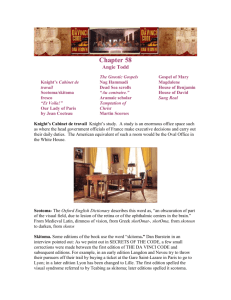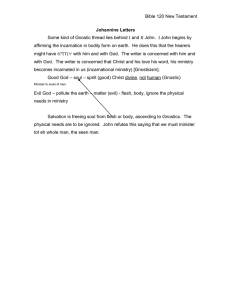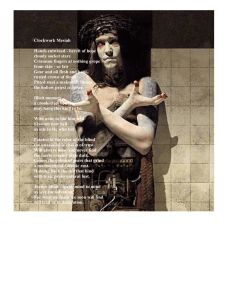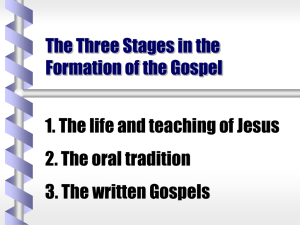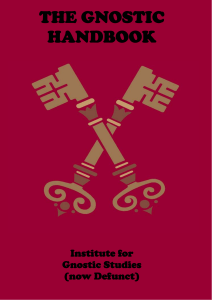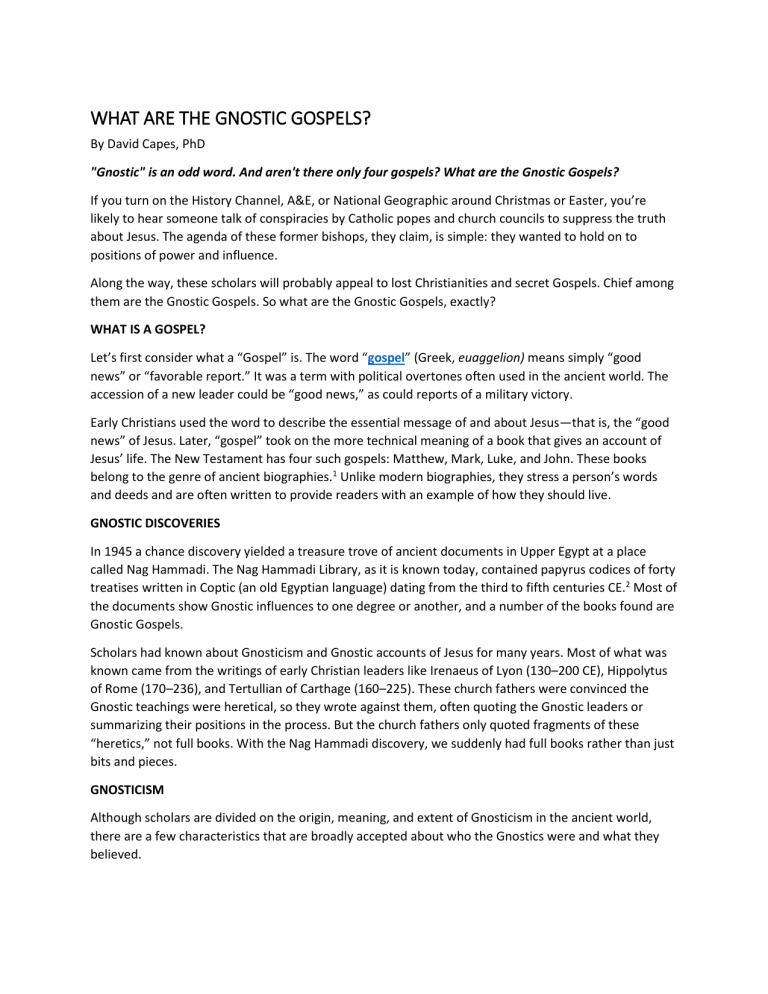
WHAT ARE THE GNOSTIC GOSPELS? By David Capes, PhD "Gnostic" is an odd word. And aren't there only four gospels? What are the Gnostic Gospels? If you turn on the History Channel, A&E, or National Geographic around Christmas or Easter, you’re likely to hear someone talk of conspiracies by Catholic popes and church councils to suppress the truth about Jesus. The agenda of these former bishops, they claim, is simple: they wanted to hold on to positions of power and influence. Along the way, these scholars will probably appeal to lost Christianities and secret Gospels. Chief among them are the Gnostic Gospels. So what are the Gnostic Gospels, exactly? WHAT IS A GOSPEL? Let’s first consider what a “Gospel” is. The word “gospel” (Greek, euaggelion) means simply “good news” or “favorable report.” It was a term with political overtones often used in the ancient world. The accession of a new leader could be “good news,” as could reports of a military victory. Early Christians used the word to describe the essential message of and about Jesus—that is, the “good news” of Jesus. Later, “gospel” took on the more technical meaning of a book that gives an account of Jesus’ life. The New Testament has four such gospels: Matthew, Mark, Luke, and John. These books belong to the genre of ancient biographies.1 Unlike modern biographies, they stress a person’s words and deeds and are often written to provide readers with an example of how they should live. GNOSTIC DISCOVERIES In 1945 a chance discovery yielded a treasure trove of ancient documents in Upper Egypt at a place called Nag Hammadi. The Nag Hammadi Library, as it is known today, contained papyrus codices of forty treatises written in Coptic (an old Egyptian language) dating from the third to fifth centuries CE.2 Most of the documents show Gnostic influences to one degree or another, and a number of the books found are Gnostic Gospels. Scholars had known about Gnosticism and Gnostic accounts of Jesus for many years. Most of what was known came from the writings of early Christian leaders like Irenaeus of Lyon (130–200 CE), Hippolytus of Rome (170–236), and Tertullian of Carthage (160–225). These church fathers were convinced the Gnostic teachings were heretical, so they wrote against them, often quoting the Gnostic leaders or summarizing their positions in the process. But the church fathers only quoted fragments of these “heretics,” not full books. With the Nag Hammadi discovery, we suddenly had full books rather than just bits and pieces. GNOSTICISM Although scholars are divided on the origin, meaning, and extent of Gnosticism in the ancient world, there are a few characteristics that are broadly accepted about who the Gnostics were and what they believed. “Gnosticism” is a word used today to describe several complex religious–philosophical movements that flourished from the second to the fourth century AD. It is important to realize that Gnosticism is not a single movement; it is a term used to characterize a variety of movements with particular beliefs and practices led by influential leaders in this specific time period. At the heart of the Gnostic worldview is the belief that the material world is evil and corrupt; in contrast, the spiritual world is good and pristine. This is easy to demonstrate. Take a nice, fresh apple and put it on a table. What happens to it over a few days, a few weeks, a few months? Before long the apple rots and becomes a smelly mess. Repeat the experiment with a piece of iron. Over time the iron rusts, corrodes, and eventually disintegrates. Try the experiment with a twenty-year-old. At twenty, a person is fit and trim; they feel and look well. Fast-forward fifty years and the same person is now old and tired; their once-firm body sags and hurts most of the time. Before long, they have died and their corpses have decomposed. Graphic, yes, but it proves a point: Everything we can see and touch in this material world suffers the same fate. It corrodes, decays, and eventually disappears. The Gnostics considered this material world inferior and evil because corruption was constantly at work in it—as anyone could observe. Since this world is so corrupt and transitory, Gnostics reasoned that the Supreme God—whom they considered to be utterly transcendent and unknowable—could not have made the present world. So they posited that creation was the work of a lower, inferior god called the Demiurge. The God recorded in the biblical book of Genesis, therefore, was not the Most High God but an inferior, second-class god. According to Gnosticism, human beings are good spirits trapped inside of evil material bodies. The good spirit originated in the sublime spiritual realm above. The problem for all people is that in the journey from heaven to earth, people forgot their true origin and nature. The Supreme God answers by sending a Redeemer from the heavenly realm to the world below in order to reveal the truth to those who have fallen into a forgetful sleep. Salvation, then, depends on receiving that knowledge and being awakened from slumber. It means that when people die, their spirits escape the bonds of this material world and ascend to the heavens to be reunited with the One above. According to Gnostic thinking, the Redeemer had to come to earth in order to reveal the truth to humans, but could not be truly incarnate—that is, enfleshed—because flesh is evil. So Christ just appeared to be human during his earthly sojourn; he was in fact only divine. This is a departure from tradition Christian belief, which states that Jesus was fully human and fully divine. THE GNOSTIC GOSPELS To one degree or another, the Gnostic Gospels reflect these teachings. Often they appear to rewrite familiar stories with a twist. In some cases they may contain early, independently attested traditions (e.g., the Gospel of Thomas). Here is a partial list of the Gnostic Gospels, along with an approximate date during which each was composed: The Gospel of Thomas (second century CE) The Gospel of Truth (second century CE) The Gospel of Judas (second century CE) The Gospel of Peter (second century CE) The Gospel of Mary (second century CE) The Gospel of Philip (second–third centuries CE) The Gospel of the Egyptians (second–third centuries CE) In addition, there are other Gnostic texts that narrate aspects of Jesus’ life, though they are not known as gospels: Sophia of Jesus Christ (second century CE) Pistis Sophia (second century CE) Apocalypse of Peter (second–third centuries CE) Apocryphon of John (second–third centuries CE) Second Treatise of the Great Seth (third century CE) Hypostasis of the Archons (third century CE) Tripartite Tractate (third–fourth centuries CE) The Gnostic Gospels were written and read in various Chrisƒtian communities in Egypt, Syria, and Asia Minor from the second to fifth centuries. Scholars debate whether they tell us anything true about the Jesus. Where all agree, however, is that they tell us a great deal about the Christian communities who used them.3 FOOTNOTES 1. Richard Burridge and Graham Stanton, What Are the Gospels? A Comparison with GraecoRoman Biography, 2nd ed. (Grand Rapids, MI: Eerdmans, 2004). 2. James M. Robinson, ed., The Nag Hammadi Library, rev. ed. (Leiden, Netherlands: E. J. Brill, 1988). Some parts of Gnostic manuscripts were also found in Oxyrhyncus, Egypt. 3. April DeConick hosts an important blog dedicated to the Nag Hammadi Collection, the Tchacos Codox (the Gospel of Judas), and other early Christian writings at www.forbiddengospels.blogspot.com. David B. Capes David B. Capes (PhD, Southwestern Baptist Theological Seminary) is senior research scholar at Lanier Theological Library in Houston, Texas. He previously taught at Wheaton College and at Houston Baptist University. He has authored, coauthored, or edited many books, including Rediscovering Jesus: An Introduction to Biblical, Religious and Cultural Perspectives on Christ; Rediscovering Paul: An Introduction to His World, Letters, and Theology; and Old Testament Yahweh Texts in Paul's Christology.
